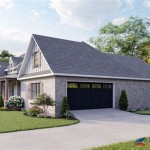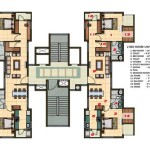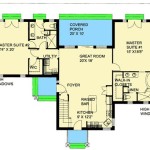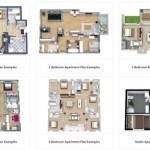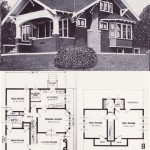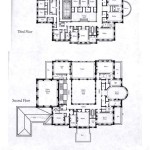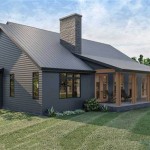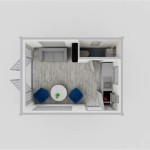Open Floor Plans With High Ceilings: An Architectural Exploration
Open floor plans and high ceilings are increasingly popular architectural choices, frequently combined to create visually expansive and aesthetically pleasing living spaces. This design approach fundamentally alters the relationship between internal space and the occupants’ perception of it. Understanding the implications of these elements is crucial for effective design and construction.
The concept of an open floor plan revolves around minimizing internal walls, particularly between living, dining, and kitchen areas. This creates a large, contiguous space that encourages social interaction and maximizes natural light penetration. High ceilings, defined as exceeding the standard eight to nine feet, further amplify this effect, drawing the eye upward and contributing to a sense of grandeur and spaciousness. The combination offers distinct advantages and presents specific design challenges that must be carefully considered.
The integration of open floor plans and high ceilings is not a recent phenomenon, although its popularity fluctuates with changing architectural trends. Historical precedents can be found in various architectural styles, adapted and refined over time. Today's iteration often incorporates modern materials and building techniques to achieve energy efficiency and structural integrity, while maintaining the desired aesthetic. This article will explore the key benefits, design considerations, and potential drawbacks associated with open floor plans featuring high ceilings.
Enhanced Natural Light and Ventilation
One of the primary benefits of combining open floor plans with high ceilings is the significant improvement in natural light distribution. By eliminating interior walls, light from windows can penetrate deeper into the living space, reducing the need for artificial lighting during the day. High ceilings further enhance this effect by allowing for larger windows, especially clerestory windows positioned high on the walls. These windows capture more sunlight and distribute it more evenly throughout the space.
Beyond illumination, high ceilings facilitate natural ventilation. Warm air rises, and in spaces with high ceilings, this creates a stack effect, encouraging the upward movement of warm, stale air. When combined with strategically placed operable windows, this natural airflow can significantly reduce reliance on mechanical air conditioning, leading to energy savings and improved indoor air quality. The natural ventilation also creates a more breathable and comfortable environment.
The effectiveness of natural light and ventilation is influenced by several factors, including the orientation of the building, the size and placement of windows, and the climate. South-facing windows, for example, provide maximum sunlight exposure in the Northern Hemisphere, while strategically placed ventilation openings can harness prevailing winds. Careful planning and consideration of these factors are essential for optimizing the benefits of open floor plans with high ceilings.
Creating a Sense of Spaciousness and Grandeur
The psychological impact of high ceilings on occupants is substantial. They contribute to a feeling of openness, freedom, and grandeur, reducing the sense of confinement often associated with smaller or lower-ceilinged spaces. This spatial expansion can positively influence mood and well-being. The open floor plan complements this by providing uninterrupted sightlines, further enhancing the perception of spaciousness.
This sense of spaciousness can be particularly valuable in smaller homes or apartments, where it can make the living area feel larger and more inviting. In larger homes, high ceilings can create a sense of drama and sophistication, especially when combined with architectural details such as exposed beams, skylights, or grand chandeliers. The visual impact is amplified by the uninterrupted expanse of the open floor plan, allowing these features to become focal points.
The feeling of grandeur can be further enhanced by strategically using vertical elements within the design. Tall bookshelves, floor-to-ceiling curtains, or statement artwork can emphasize the height of the ceilings and draw the eye upward, reinforcing the sense of spaciousness. Careful attention to scale and proportion is critical to avoid overwhelming the space or creating a feeling of imbalance.
Design Considerations and Potential Drawbacks
While open floor plans with high ceilings offer numerous benefits, they also present specific design challenges. Acoustics, heating and cooling efficiency, and privacy are key considerations that must be addressed to ensure a comfortable and functional living environment.
Acoustics can be a significant issue in open spaces with high ceilings. Sound waves tend to reverberate more in these environments, leading to increased noise levels and reduced speech intelligibility. This can be particularly problematic in homes with hard flooring surfaces. To mitigate these issues, it is essential to incorporate sound-absorbing materials such as carpets, rugs, upholstered furniture, and acoustic panels into the design. Strategic placement of these materials can effectively dampen sound waves and improve acoustic comfort.
Heating and cooling efficiency can also be a challenge. Larger volumes of air require more energy to heat or cool, potentially leading to higher energy bills. The stack effect, while beneficial for natural ventilation, can also contribute to heat loss in the winter. Effective insulation is crucial for minimizing heat loss and gain. Additionally, the use of ceiling fans can help to circulate air and distribute heat more evenly throughout the space. Zoning systems, which allow for independent temperature control in different areas of the home, can also improve energy efficiency.
Privacy can be another concern in open floor plans. The lack of interior walls can make it difficult to create private spaces for work, relaxation, or conversation. Flexible design solutions, such as partial walls, screens, or strategically placed furniture, can be used to create a sense of separation without completely closing off the space. Incorporating different levels or platforms can also visually define different areas within the open floor plan. Careful consideration should be given to the needs of all occupants when designing for privacy in an open concept layout.
Beyond these core considerations, the structural implications of high ceilings must also be addressed. Taller walls require additional support, potentially leading to increased construction costs. Collaboration between architects, engineers, and contractors is essential to ensure the structural integrity of the building. Furthermore, the selection of appropriate materials and construction techniques is crucial for achieving both aesthetic and functional goals.
The aesthetic design of an open floor plan with high ceilings presents its own unique challenges. The large, uninterrupted space requires careful consideration of furniture placement, lighting design, and overall style. Overcrowding the space can negate the feeling of spaciousness, while leaving it too bare can create a cold and uninviting atmosphere. Striking a balance between functionality and aesthetics is key to creating a harmonious and comfortable living environment. The vertical space also needs to be considered. Leaving the tall walls empty can make the space feel incomplete.
In summary, open floor plans with high ceilings offer significant advantages in terms of natural light, ventilation, and spatial perception. However, careful planning and consideration of design challenges are essential for creating a comfortable, functional, and energy-efficient living space. Acoustical treatments, insulation, privacy solutions, and structural considerations must be addressed to fully realize the potential of this design approach.

Benefits Of Open Floor Concepts And High Ceilings Ameri Star Homes

Luxury Contemporary Style House Plan 5074 Maclennon

Cathedral Ceiling House Plans Small W High Ceilings

Floor Plan Friday 3 Bedroom Modern House With High Ceilings Open

High Ceilings And Materials Are Prominent Design Elements In This New House

Pin Page

Open Plan Loft With Amazingly High Ceilings

Beautiful Living Room Interior In New Luxury Home Features Floor To Ceiling Fireplace Surround Tall Ceilings Built Shelving And Open Concept Plan Shows Foyer Stock Foto Adobe

Home

High Ceiling House Plans Over 8

